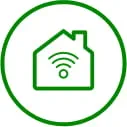Back in the day, the family doctor would make house calls to check up on you in the comfort of your home. Over time, medical care became consolidated in clinics and hospitals and the country doctor became a relic of the past. But in recent years an almost hybrid version of healthcare has emerged as more people are turning to telehealth. With telehealth, or telemedicine, individuals have the privilege of seeing a doctor or nurse practitioner in the comfort of their home, sometimes on demand.
Virtual healthcare has been on the rise since the Covid-19 pandemic and is likely to continue increasing in popularity. Not only is it popular with many people who don’t want to deal with the hassle of taking time out of their day to get to an appointment for a minor concern, but telehealth can also make an impact on bigger problems, like the shortage of healthcare workers and the rise of chronic health conditions. Seeing patients with easy-to-treat conditions online can free up healthcare facilities and staff to focus on the more complicated and serious medical cases. Americans with chronic conditions can access health management tools online and stay connected to their doctors and regimens without the additional challenge of having to get to a healthcare facility for regular checkups.
As telemedicine continues to grow in demand and availability, the need for reliable internet becomes even more critical. Not only do patients need a high-speed connection that won’t drop, glitch or get stuck loading, but healthcare providers also need security for sensitive information and a network that won’t fail them. For these reasons and more, fiber internet is a superior choice for telehealth.
Fiber-optic internet, explainedHere are some reasons why the future of virtual healthcare relies on the dependability and speed of fiber internet.
Ultra-fast connectivity
Fiber-optic internet provides unparalleled speed and reliability. The high bandwidth capabilities of fiber enable seamless transmission of large data files, high-resolution images and real-time video consultations. This is particularly crucial in telemedicine, where prompt and accurate communication between healthcare professionals and patients is essential.
Ziply Fiber offers residential customers up to 50 gigabits of symmetrical upload/download speeds — the fastest in the country. For commercial clients, like healthcare providers, speeds are not only much faster than cable, but the connection also operates with extra bandwidth to ensure that the connection doesn’t get congested and slow down.
Low latency
Fiber internet has extremely low latency due to its symmetrical speeds and extra capacity. In telemedicine, where split-second decisions can be critical, low latency ensures that there is minimal lag during video consultations, enabling a smoother and more natural interaction between healthcare providers and patients.
HD video quality
Video conferencing is the whole point of virtual healthcare. Fiber-optic internet ensures high-definition (HD) video quality, allowing healthcare professionals to conduct thorough examinations and assessments remotely. This visual clarity is indispensable for accurate diagnostics and patient communication.
Reliability and stability
Fiber internet is known for its reliability and stability. Unlike traditional broadband or DSL connections, fiber is less susceptible to interference and external factors like weather conditions. This stability is crucial in telemedicine scenarios, where interruptions or downtime can compromise patient care. At Ziply Fiber, interruptions to service due to maintenance or damage to a fiber line are mitigated by a fully redundant network that keeps customers online all the time.
Fiber internet is built for the future
Secure data transmission
Telemedicine involves the exchange of sensitive and confidential patient information. Fiber-optic internet offers enhanced security features, reducing the risk of data breaches and unauthorized access. This is a crucial aspect in maintaining patient privacy and complying with HIPAA.
Support for remote monitoring
Fiber internet facilitates the seamless integration of remote monitoring devices and sensors. This enables healthcare providers to remotely monitor patients’ vital signs and health parameters in real-time, offering a proactive approach to healthcare management.
Scalability for growing telemedicine practices
As telemedicine practices expand, the demand for scalable internet solutions grows, too. Fiber-optic internet can accommodate the growing needs of telehealth services, providing a reliable and scalable infrastructure to support increased data volume and user connections.
Learn more about Ziply Fiber’s opportunities for the medical field
As telemedicine becomes more mainstream, it will need technology that not only keeps up with it, but also grows with it. Fiber-optic internet brings the speed, reliability, scalability and security necessary for successful healthcare visits that improve the health conditions of people around the country, free up providers to focus on critical care and ensure that data and personal information is secure. For medical facilities with virtual health options, fiber internet is an obvious choice.






